Tower crane demand remains resilient
04 November 2020
Despite the economic slowdown caused by the Covid-19 crisis, tower crane fleet utilization remains solid
As the days of 2020 dwindle, the crane industry continues to feel the ill effects of the global pandemic that began impacting North America in early March. Because construction was deemed “essential business” in most states, the crane, rigging and specialized transportation sector saw slowdowns but not shutdowns. The tower crane industry appears to be holding its own in most markets.

Solid pace
Sam Moyer, general manager of ALL Erection’s tower crane division, said that if a crane was on rent at the start of the pandemic, it most likely stayed up until its work was done. That created a cushion.
“The pandemic obviously created a lot of uncertainty, but I would say the market has proved surprisingly resilient,” he said. “We’re still working at a solid pace. If anything, the changes in plans some of our customers experienced actually steadied our usage, because it extended some start dates. It is also giving us a clearer picture of where we will stand at the start the new year. We know what’s coming and everything looks strong.”
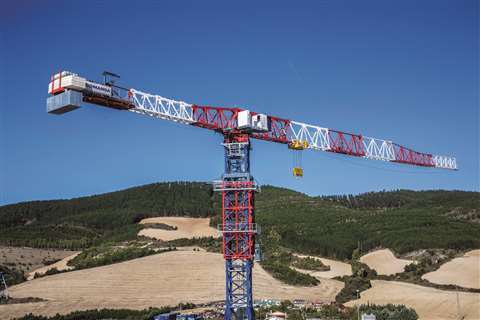
Comansa 21LC1400
While utilization has been solid, Moyer said planned purchases have become more selective and targeted to customer needs. Over the summer, ALL purchased two new self-erecting tower cranes to address smaller commercial projects and multi-family housing projects. The third purchase was a high-speed hoist luffing-jib tower crane that is in demand for city-center high-rise construction.
“We build relationships with our customers and take their feedback, then select equipment accordingly,” he said. “Our planning is based on the demand they’re seeing and the kinds of jobs they’re pursuing.”
The challenge ahead is preparing for demand.

“We believe there is a pent-up desire to build and, at some point, the floodgates will open,” he said. “Will it happen all in one quarter? Or will it be a slower build throughout all of next year? We need to keep our finger on the pulse of the industry so we can respond when our customers need us. That is the most important thing, that we’re ready with the equipment they need when they need it.”
Peter Juhren, president and COO of Morrow Equipment, said the last part of 2020 may be the softest quarter of the year.
“The market has softened a bit mainly due to Covid and a tightening of the credit markets,” he said. “While the slowdown has not been drastic, the effects are being felt and the fourth quarter 2020 and first quarter of 2021 will remain this way.”
He said the U.S. election will impact future projections.
Fleet additions
Morrow, which owns, rents and distributes Liebherr tower cranes, has cranes on order.
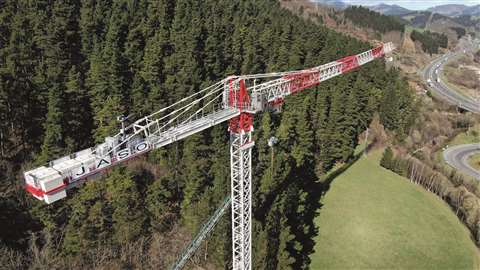
“We are buying on as-needed basis right now,” Juhren said. “We are looking at growth in 2021 in segments of the tower crane market and strategically targeting regions, which will require new acquisitions.”
Juhren said rental rates are a challenge.
“Rates are pushing downwards as companies look more at utilization than return on investment,” he said. “This is having an effect on rental rates increasing competition regionally. All-inclusive packaging (turn-key) is also driving the market, and companies are absorbing these costs to gain market share.”
Bill Carbeau, vice president of business development for Comansa America, said his company has experienced a waiting pattern for new purchases.
“Covid has caused much uncertainty so people were waiting,” he said. “But now it is close enough to the election that people want to wait and see that outcome first. We had an order cancel because of college football confusion and a customer that decided not to buy because he was afraid of the election possible outcome.”
But on the other hand, Comansa America’s rental divisions are continuing to add cranes at a moderate rate, Carbeau said.
“Purchases follow demand as realistically as possible,” he said. “We are fortunate that our markets are busy.”
Among the many challenges created by the Covid-19 crisis, Carbeau misses the customer interaction.
“Right now, it is difficult to reach potential customers because of travel restrictions,” he said. “My first planned trip for business was last week.”
He had not travelled on business since ConExpo in March.
Dennis “Whitey” Lebsack, director of business development for RMS Cranes, said projects are being pushed into 2021 with schedules being held.
While RMS will purchase new cranes if needed, Lebsack said “the main focus is to get our inventory, which is well rounded for our market, up and working. The biggest challenge is getting the developers to cut loose the back logged and new work.”
Todd Yager, president of U.S. operations for Wolffkran, said that his company is addressing 2021 with “concern and caution.” However, new tower cranes are being sold.
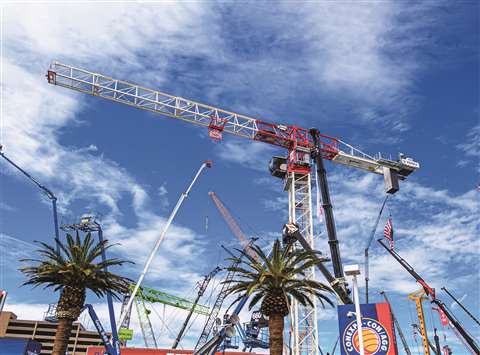
“Our dealers are driving this,” he said. “We work closely with them in forecasting and meeting their tower crane needs. The biggest challenges are uncertainty of the economy, price pressures, Covid-19 and how it will affect the need for high-rise offices and residential buildings.”
Following is an overview of the latest tower crane products on the market.
Comansa
Comansa introduced several new flat top tower crane models in 2020, all in the popular 2100 series, the company said. Comansa’s modular design makes it easy to adapt the development process to new models. In 2020 Comansa introduced the 21LC600-20T and 25T, and 21LC650-20T and 25T models. All are equipped with the award-winning cube cabin and available quick set for fast setup at erection.
The 21LC1400 and 21LC1050 models are designed specifically for Prefabricated Prefinished Volumetric Construction, PPVC, where high capacities and precision lifting are required. They are also in demand for large civil and mining applications. Both models have jib lengths up to 85 meters extendable to 90 meters and several counter jib lengths to maximize lifting capacities.
All Comansa tower cranes have pin connected modular tower sections, jib and counter jib components so no re-torque is required. All models have the automatic trolley reeving changeover that increases jib tip capacity when needed.
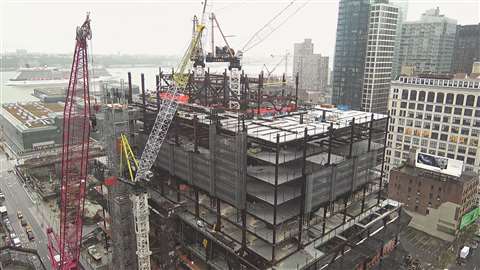
FM GRU
FM GRU’s latest models include the FM 2052 LK. Designed for working on congested construction sites, the 37 Kw motor allows the jib to reach the vertical position in only 1.6 minutes. The crane features a special hoisting winch allowing the operator to choose between two speed ranges with the possibility to select the super-reduced speed. This system allows the optimization of lifting speeds according to the loads, the company said.
The new cabin was designed to improve operator visibility with the ability to visually follow the hook in every position. This crane has an advanced safety system that avoids the contact/crash of the load with the cabin/operator due to an extra luffing limit-switch. The crane has dual redundant sensors and features easy set-up, an automatic ultra-lift system, anti-collision and zoning devices and a hook-flat system.
Jaso
Last spring Jaso launched its largest tower crane, the J800.48. It follows the company’s same low top design principle with a short top that is just a fraction of the height of a true hammerhead.
When comparing with like tower cranes, there is actually no difference in the clearance heights of flat-tops and this Jaso low-top, because flat-top designs need deeper jibs compensating the pendant height giving the boom the strength of a hammerhead, the company said.
The new J800.48 is designed for loads requiring a capacity between 18 and 21 metric tons at 40 meters with a maximum boom of 60 meters. With a shorter jib, it has the capacity to work for PPVC type construction where typical loads are 35 to 40 metric tons.
There is one 23-meter pendant section that is easily lifed as one piece during setup with the first two boom sections.
The rest of the jib is offered almost completely with 2.5 meter intervals. Minimal swing radius can be reached by using four modular counter jib configurations. The counter jib radius ranges from 18.6 to 28 meters.
Capacity with double rope reeving is 48 metric tons or 24 metric tons with single reeving. Tip load capacity at 80 meters jib is 5.1 metric tons. The standard hoist is 110kW hoist motor while an optional 132kW gives a max line speed of 150 meters per minute. The hoist winch features a Lebus drum specially designed for Jaso, with a capacity to provide max hook height of 455 meters in single reeving or 227 meters in double-reeved.
Favelle Favco
Favelle Favco Cranes is replacing its popular M760E diesel hydraulic tower crane with a new model, the M900F-ST. The Favco M760E has played a prominent role in many high-rise construction projects in New York City such the World Trade Center, Hudson Yards and One Vanderbilt.
The new M900F-ST model was introduced in late 2019, and since then the company has secured several orders for this new machine.
The M900F-ST is a heavy-duty version of the M760E. The maximum capacity of the M900F-ST is exactly the same as the M760E at 141,000 pounds but has much better load charts. With a 180-foot boom, the M900F-ST has a tip load that is more than 40 percent better than the M760E. With 210 feet of boom, the M900F-ST has a tip load that is almost 50 percent more than the M760E.
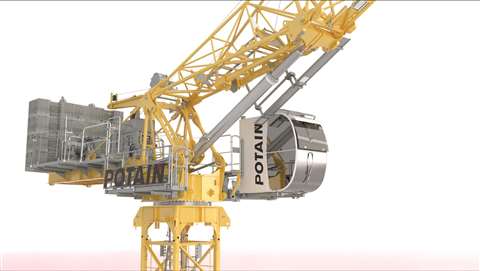
Similar to the M760E, the M900F-ST runs on a 540 HP Caterpillar T4 engine. The main winch has a 70,400 pound capacity and the fly winch has a 26,400 pounds capacity. The hoist speeds on the M900F-ST are comparable to the M760E. In the last two years, Favelle Favco has reconfigured the counterweights on its cranes to reduce the tail swing radius. The M900F-ST has a 25-foot tail radius. This is 4 feet shorter than the conventional M760E. The M900F-ST also comes with the latest Favelle Favco in-house Linec electronic crane control system incorporating the latest software. Favelle Favco is offering the M900F-ST in diesel hydraulic, fully electric or electrohydraulic version.
Potain
Potain’s MRH 175 tower crane made its debut earlier this year at ConExpo 2020. The crane is aimed at one of the busiest sectors in the built environment: high-rise construction.
The MRH 175 is the latest release in Potain’s line of hydraulic luffing jib cranes, a product line the company has continuously developed since unveiling the MRH 125 a year and a half ago.
Manitowoc has championed this category of cranes, with dozens of models already delivered to a range of markets. Combining the advantages of Potain’s MR luffing jib cranes and MDT topless cranes, contractors find them particularly straightforward to assemble and disassemble on congested sites, making them ideal for urban projects, high-rise construction or jobsites where space is limited, according to the company.
Maximum capacity for the MRH 175 is 11 tons while the maximum jib length is 180 feet. Tip capacity is 1.65 tons when working with the full 180-foot jib, or 3 tons if fitted with 164 feet of jib. Maximum line speed is 705 feet per minute working with the high-performance 90HPL25 hoist.
The crane’s unique design, with its fixed counter jib and topless structure, facilitates its fast erection and dismantling, as well as making it more compact for transport, needing only four standard containers. The elements weigh under 8.5 tons and there is a single counter-jib/jib foot package.
The topless design also means less space is needed on sites where multiple cranes overfly the jobsite and the hydraulic design means no wire rope installation is needed. It also means a smaller assist crane is needed for erection as there is no cathead to assemble.
Potain’s hydraulic luffing design features a shorter counter-jib and out-of-service radius than rope-luffing alternatives. This frees up valuable space on jobsites, with the MRH 175 delivering an out-of-service radius of only 33.5 feet, regardless of jib length, the company said.
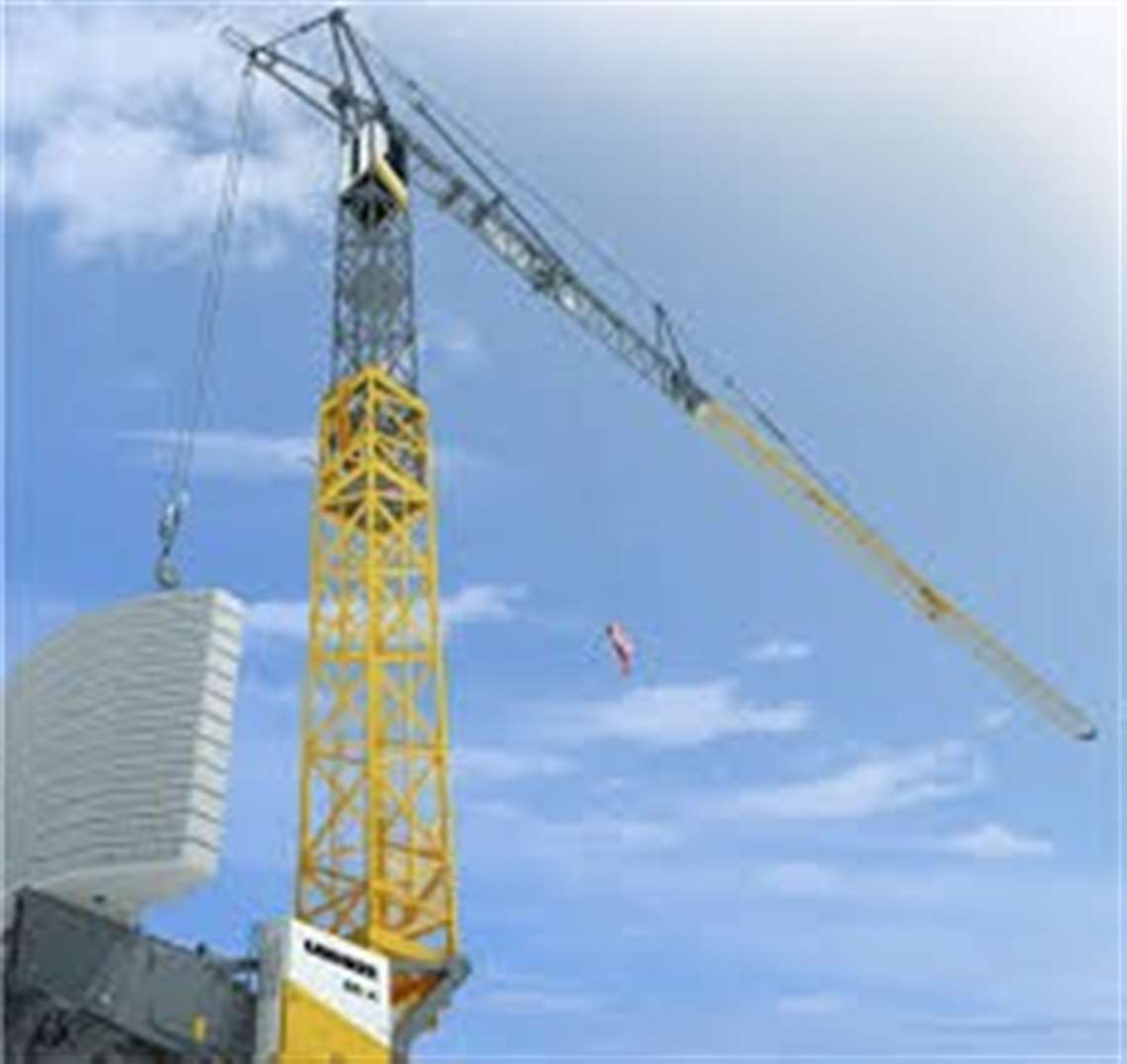 Liebherr 125K
Liebherr 125K
Freestanding heights of up to 206 feet are available with the 6.5-foot K-mast sections, and the crane is also compatible with 5.2-foot K-mast sections. On the hoisting drum, up to 3,136 feet of rope is available with the 90HPL25 winch, allowing users to choose either 1,568 feet in a two-fall configuration with a 5.5-ton maximum capacity or 784 feet in a four-fall configuration with an 11-ton maximum capacity. Luffing the crane from the horizontal to vertical is efficient, taking less than two minutes, Manitowoc said.
Liebherr
Liebherr’s latest model is the 125 K. With a radius of 180 feet and a maximum hook height of 215 feet it is currently the largest fast-erecting crane on the market, the company said. The 125 K has an initial hook height of 97 feet. Five tower sections can be inserted to reach a total hook height of 136 feet. The 30-degree luffed jib position enables a 215-foot hook height.
The crane has a 17,600 pound maximum load capacity and with a 180 foot radius at the jib head, it is able to lift 2,800 pounds due to its Load-Plus function. It has five radius options, ranging from 114 to 180 feet. With its 10-foot slewing radius, the Liebherr 125 K fast-erecting crane can fit in small spaces. The variable slewing radius can be extended to 13 feet. Site lighting is now available with LED floodlights to ensure even better site illumination.
Liebherr’s external K-crane cabin is also available for the 125 K. In the past, large fast-erecting cranes could only be transported via semi-trailer. But the 125 K can also be towed as a trailer by a conventional truck using Liebherr’s axle system LiTRAX.
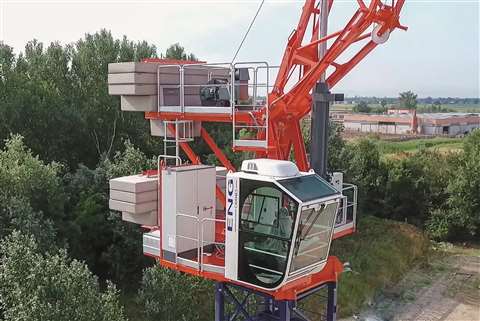
Liebherr also presented its 340 EC-B flat top series at ConExpo. Three of the eight units are equipped with fiber rope, which the company said has a four times longer service life than steel rope and enables fiber rope cranes to work with a significantly higher load capacity.
The first eight units of the new series have maximum load capacities that range from 13,200 to 35,200 pounds and the maximum jib head load capacities range from 3,500 to 13,200 pounds, working at a maximum radius. At full jib length, the units are among the largest in their class. The two largest cranes in the series, the 340 EC-B 12 and the 370 EC-B 12 Fiber, each have a reach of up to 255 feet.
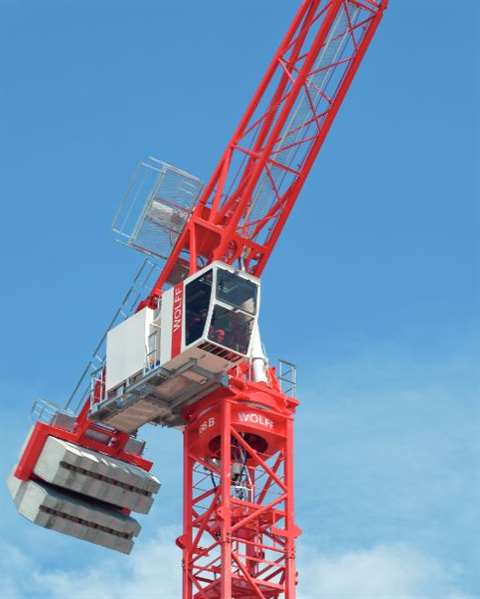
Liebherr has also developed a new tower system, the 12 EC 125, for the 125 EC-B 6 as part of the new series. The 12 EC tower system comes in two lifting capacities: the 12 EC 100 and the 12 EC 125. The first eight cranes in the new EC-B series are the 125 EC-B 6, the 220 EC-B 10, the 220 EC-B 12, the 240 EC-B 10 Fibre, the 240 EC-B 12 Fibre, the 340 EC-B 12, the 340 EC-B 16 and the 370 EC-B 12 Fibre.
ENG Cranes
ENG Cranes’ latest launch is the EDL 150, at 10 tons capacity, it is the first hydraulic luffer with the shortest radius available on the market. Its system of the double patented counterjib of only 4.1 meters makes it unique in its kind and allows erection on complex urban jobsites where there is not much space and other cranes of this type cannot be installed.
The EDL 15 can be used both as a luffer and traditional flat-cop crane. ENG Cranes also introduced a new line that includes the EDL 110-8 tons, EDL 150-10 tons and EDL 210-12 tons.
Wolffkran
Due to its impressive performance and compact design, the WOLFF 166 B has quickly developed into a bestselling crane for Wolffkran, the company said. This year, Wolffkran launched a U.S. version of the WOLFF 166 B, which is compliant with U.S. electrical standards and structural components requirements.
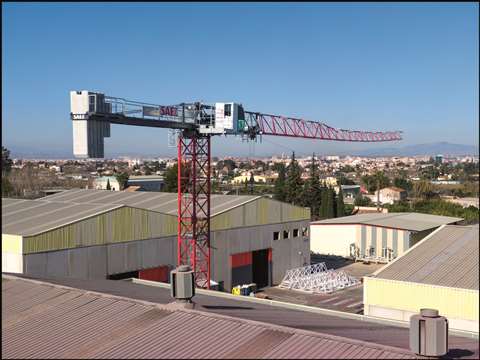
Saez TLS 75 14T SR
Unlike cranes with a winch-driven luffing gear, the WOLFF 166 B US is fitted with a compact hydraulic luffing mechanism that eliminates the need for classical tower top and reeving of the luffing rope, making both transportation and assembly more efficient. The hydraulic design also allows for a smaller out-of-service jib position, which is important on inner-city construction sites.
The WOLFF 166 B US is fitted with a powerful 60 kW and offers a maximum load capacity of 26,460 pounds in two-fall operation. It achieves a best-in-class tip load capacity of 7,270 pounds with a 164-foot jib. Fast line speeds of up to 377 feet per minute and a luffing movement from maximum to minimum jib radius in only 90 seconds make it ideal for high volume in-situ concrete work. It can be erected with a freestanding tower height of 306 feet and has a maximum hook path of 1,640 feet.
Saez
Saez has launched a new flat top, the TLS 75 14T SR, which will be available in late November. Saez is also unveiling the new flat top TLS 80 20T and a version of the TLS 80 32T, which is specifically designed for the U.S. market.

Raimondi
The LR372 is the latest crane in the Raimondi Cranes lineup. Equipped with Raimondi’s next generation high performance winches, the LR372 is a 370 ton-meter class luffing tower crane with a maximum jib length of 60 meters and a maximum capacity of 20,000 kilograms in two falls configuration.
At the maximum radius, the LR372 can lift 3,795 kilograms using Ultralift mode, making this Raimondi’s most powerful luffing crane to date. One very important feature of the LR372 is that it may be installed on two different types of towers: for an internal climbing system, the new GR5H tower at a width of 2 meters, or the 2.3 meter width GR6 tower series (GR6B, GR6 and GR6L inclusive), for standard, external and internal climbing configurations, according to the company.
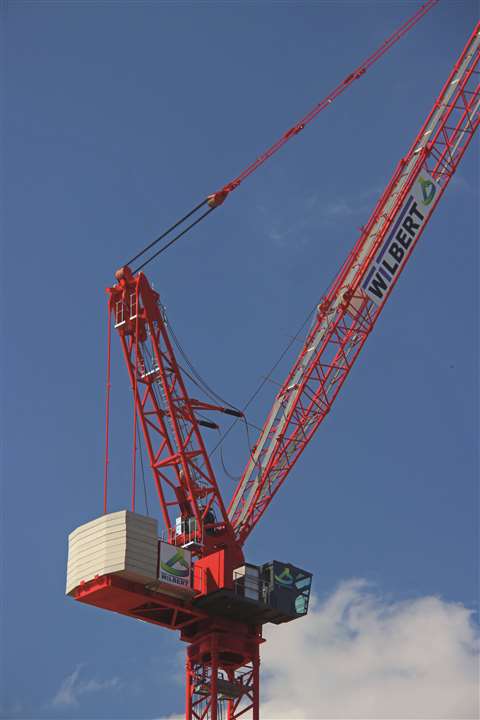
Wilbert WT 555L e.tronic
The GR6L towers can be installed on embedded legs and on an 8-by-8 inch addition to the new 6-by-6 meter strut cross base with or without travelling system. The GR5H towers can be installed on embedded elements and on a 6-by-6 meter strut cross base.
The LR372’s luffing movement, using the new 75 kW winch, is equipped with a standard emergency brake. The raise of the jib from 14.5 degrees to 85 degrees takes approximately 2.1 minutes with full load. The LR372 can reach a maximum lifting speed of approximately 256 meters per minute.
Wilbert
The new Wilbert WT 555L e.tronic is ideal for use on narrow construction sites in urban areas.
At the maximum radius of 61.5 meters, the crane has a load capacity of 6.2 tons and boasts a work speed of 100 meters per minute at 2 tons and 20 meters per minute at full load capacity at 32 tons. Designed using a sophisticated modular system, the machine has freestanding hook heights of up to 100 meters with standard tower elements and more than 130 meters with newly designed, reinforced tower elements, a maximum jib length of up to 61.5 meters and a standard jib length of 6 meters and 12 meters, and a load capacity of up to 32 tons with a jib end load of 6.2 tons.
It features the newly developed control and drive technology, stepless acceleration over the entire speed range and fast acceleration and deceleration of the load without vibrations of the hoist rope. The machine was built with new assistance systems such as wind-start control, brake-match, anti-sway and position mode ensure maximum safety and precise crane operation.
STAY CONNECTED


Receive the information you need when you need it through our world-leading magazines, newsletters and daily briefings.



